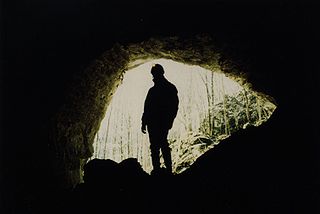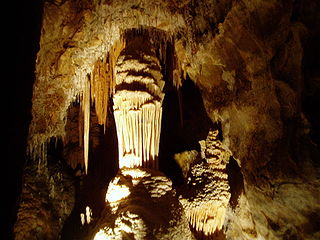Related Research Articles

Karst is a topography formed from the dissolution of soluble carbonate rocks such as limestone and dolomite. It is characterized by features like poljes above and drainage systems with sinkholes and caves underground. There is some evidence that karst may occur in more weathering-resistant rocks such as quartzite given the right conditions.

Speleology is the scientific study of caves and other karst features, as well as their composition, structure, physical properties, history, ecology, and the processes by which they form (speleogenesis) and change over time (speleomorphology). The term speleology is also sometimes applied to the recreational activity of exploring caves, but this is more properly known as caving, potholing, or spelunking. Speleology and caving are often connected, as the physical skills required for in situ study are the same.
Formed in 1956, the Australian Speleological Federation Inc. (ASF) is the national body representing those interested in the protection and sustainability of Australia's cave and karst environments. It has approximately 950 members across 24 caving clubs throughout all Australian states and territories.

The Jenolan Caves are limestone caves located within the Jenolan Karst Conservation Reserve in the Central Tablelands region, west of the Blue Mountains, in Jenolan, Oberon Council, New South Wales, in eastern Australia. The caves and 3,083-hectare (7,620-acre) reserve are situated approximately 175 kilometres (109 mi) west of Sydney, 20 kilometres (12 mi) east of Oberon and 30 kilometres (19 mi) west of Katoomba. Dating back to 340million years ago, it is the oldest known and dated open cave system in the world.

Primož Jakopin, born 30 June 1949 is a Slovenian computer scientist, known for his work in the field of language technology and his contribution to speleology.
Postojna Cave is a 24.34 km (15.12 mi) long karst cave system near Postojna, southwestern Slovenia. It is the second-longest cave system in the country as well as one of its top tourism sites. The caves were created by the Pivka River.

The caves of the Mendip Hills are formed by the particular geology of the Mendip Hills: large areas of limestone worn away by water makes it a national centre for caving. The hills conceal the largest underground river system in Britain.

The British Cave Research Association (BCRA) is a speleological organisation in the United Kingdom. Its object is to promote the study of caves and associated phenomena, and it attains this by supporting cave and karst research, encouraging original exploration, collecting and publishing speleological information, maintaining a library and organising educational and scientific conferences and meetings.
There are a number of caving organizations throughout the world.

Recreational caving in the United Kingdom dates back to the mid-19th century. The four major caving areas of the United Kingdom are North Yorkshire, South Wales, Derbyshire, and the Mendips. Minor areas include Devon, North Wales, and the Scottish Highlands.
The West Virginia Speleological Survey (WVaSS) is a speleological organization and ongoing cave survey program that has gathered information and published about West Virginia caves and karst since 1967.
Charterhouse Cave, on the Mendip Hills in Somerset, is the deepest cave in southern England.
International Union of Speleology is a scientific non-governmental organization dedicated to the international promotion and coordination of cave and karst research. Founded in 1965, UIS is a member of the International Science Council in Paris and cooperates with UNESCO. In 2021–2022, UIS organized the International Year of Caves and Karst.

The Butler Cave Conservation Society (BCCS) is a 501(c)(3) non-profit Virginia corporation dedicated to the conservation, exploration, survey, preservation, and scientific study of the caves and karst in and around Burnsville Cove, Virginia.

The Cliefden Caves is a heritage-listed geoheritage site at Mandurama, in the Central West region of New South Wales, Australia. The caves comprise Ordovician fossil localities, limestone caves, a spring and tufa dams, and a site where limestone was first discovered in inland Australia.

Newcastle and Hunter Valley Speleological Society (NHVSS) is a caving club based in Newcastle, New South Wales (NSW), Australia.

Tomaž Planina was a Slovenian cave photographer, speleologist, and botanist. He was most known for his work in cave photography, laboratory rope testing, especially in connection to knots, and his contribution to the development of the single-rope technique.

Cave diving is underwater diving in water-filled caves. The equipment used varies depending on the circumstances, and ranges from breath hold to surface supplied, but almost all cave diving is done using scuba equipment, often in specialised configurations with redundancies such as sidemount or backmounted twinset. Recreational cave diving is generally considered to be a type of technical diving due to the lack of a free surface during large parts of the dive, and often involves planned decompression stops. A distinction is made by recreational diver training agencies between cave diving and cavern diving, where cavern diving is deemed to be diving in those parts of a cave where the exit to open water can be seen by natural light. An arbitrary distance limit to the open water surface may also be specified. Despite the risks, water-filled caves attract scuba divers, cavers, and speleologists due to their often unexplored nature, and present divers with a technical diving challenge.

The Ljubljana Cave Exploration Society is a Slovenian non-profit speleological organization founded in 1910 dedicated to the discovery, exploration, documentation and protection of caves in Slovenia. It is based in Ljubljana, is the oldest still active caving society in the country and is most known for its work in the deep caves of the Kanin mountain range. It discovered, explored and surveyed five caves, deeper than 1,000 meters; the 2019 connection of two such caves reduced the figure to four.
References
- ↑ "MCRA History" . Retrieved 5 February 2011.